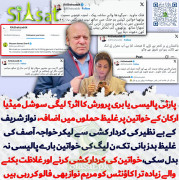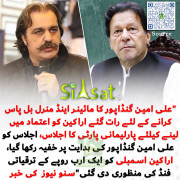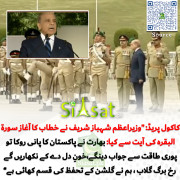Yeh wohi Dadulah tu nahain jo chohay ki tarah karachi say aik bil say pakra gia thaa aur phir amriki mafadat ki khatir qatar deal kay zariay raha ho gia thaa.....................mean hamari bili aur hamain mianooo:lol:
[h=1]Dadullah[/h] From Wikipedia, the free encyclopedia
For the insurgent group, see
Mullah Dadullah Front.
Not to be confused with the Pakistani Taliban leader
Dadullah
Maulavi or
Mullah Dadullah or
Dadullah Akhund (
Pashto:
ملا دادالله آخوند) (c. 1966 12 May 2007) was the
Taliban's senior military commander until he was killed by
British and
American special forces in
Afghanistan in 2007.[SUP]
[1][/SUP] He was an ethnic
Pashtun from the
Kakar tribe of Kalai-Kakaran village in
Uruzgan province of
Afghanistan. He also had a home in Alajilga, a border village in
Kandahar province. According to the
United Nations' list of entities belonging to or associated with the Al-Qaida organization he had been the Taliban's Minister of Construction.[SUP]
[2][/SUP]
[h=2]Contents[/h]
[h=2]Early life[/h] Dadullah lost a leg when fighting with the
Mujahideen against
Soviet occupation in the 1980s.[SUP]
[3][/SUP] He was a member of the Taliban's 10-man leadership council before the
US-led invasion in 2001. He was reportedly also a close aide to
Mullah Omar. In the period of 19992000, he led the suppression of a revolt by
Hazaras in
Bamyan province.[SUP]
[4][/SUP] When the Taliban regime fell in December 2001, Dadullah escaped capture by
Northern Alliance forces in
Kunduz province.[SUP]
[3][/SUP]
[h=2]Fight post 2001[/h] Rumors that Dadullah may be headed to recapture the city with as many as 8,000 Taliban fighters, following the November 2001
Battle of Mazar-i-Sharif, a thousand American ground forces were airlifted into the city.[SUP]
[5][/SUP]
He allegedly participated (by giving orders via cell phone) in the murder of
Ricardo Munguia on March 27, 2003. In 2005 he was sentenced
in absentia to life in prison, along with three others, by
Pakistan for the attempted murder of a member of Pakistan's parliament,
Maulana Mohammad Khan Sherani of the
Jamiat Ulema-i-Islam party. Sherani, an opponent of the Taliban, survived an
IED attack in his home constituency of
Balochistan in November, 2004.[SUP]
[6][/SUP]
A "Western intelligence source" claimed Dadullah may have been operating out of
Quetta, Pakistan.[SUP]
[7][/SUP] Others, including the Pakistani government, claimed he was operating near
Kandahar, Afghanistan. In 2006, he claimed to have 12,000 men and control 20 districts in the former Taliban heartland in the southern provinces of Kandahar,
Helmand,
Zabul and
Orūzgān.[SUP]
[8][/SUP]
Dadullah had reportedly been a central figure in the recruitment of Pakistani nationals to the Taliban[SUP]
[4][/SUP] and was also one of the main Taliban spokesmen, frequently meeting with Al-Jazeera television reporters.[SUP]
[9][/SUP] In the summer of 2006, he was reportedly sent by Mullah Omar to
South Waziristan to convince local Pashtun insurgents to agree to a
truce with Pakistan.[SUP]
[10][/SUP] In October 2006 it was rumored[SUP]
[11][/SUP] that the Afghan government was considering giving control of its defense ministry over to Dadullah as part of a reconciliation plan with the Taliban to stop the ongoing insurgency.
Mullah Dadullah was linked to massacres of Shi'a, the scorched earth policy of Shi'a villages in 2001 (which he boasted about once on the radio), and the summary execution of men suspected of throwing hand grenades into his compound in 2001 (they were hanged at one of the main roundabouts). According to an interview he gave to the
BBC, he had hundreds of
suicide bombers waiting for his orders to launch an offensive against
NATO troops.[SUP]
[12][/SUP]
Dadullah oversaw Taliban negotiations for the hostage-taking of Italian reporter
Daniele Mastrogiacomo and his two Afghan assistants in March 2007. Mastrogiacomo's driver was later beheaded. Mastrogiacomo was reportedly exchanged for five senior Taliban leaders, including Ustad Yasir, Abdul Latif Hakimi, Mansoor Ahmad, a brother of Dadullah, and two commanders identified as Hamdullah and Abdul Ghaffar. The Taliban threatened to kill the interpreter Ajmal Naqshbandi, one of the two Afghan assistants, on March 29, 2007 unless the
Kabul government freed two Taliban prisoners.[SUP]
[13][/SUP] Ajmal was later beheaded after the Afghan government refused to free anymore Taliban prisoners. According to
Asadullah Khalid, the governor of
Kandahar Province, "Mullah Dadullah was the backbone of the Taliban. He was a brutal and cruel commander who killed and beheaded Afghan civilians."[SUP]
[14][/SUP]
[h=2]Death[/h] [TABLE="class: metadata mbox-small plainlinks"]
[TR]
[TD="class: mbox-image"]
[/TD]
[TD="class: mbox-text plainlist"]
Wikisource has original text related to this article:
Dadullah interview with as-Sahab
[/TD]
[/TR]
[/TABLE]
Afghan officials reported on May 13, 2007 that Mullah Dadullah was killed the previous evening in a raid by U.S, Afghan and NATO forces, known to have included the
Special Boat Service (SBS), a British special forces unit, in Helmand Province, after he left his "sanctuary" for a meeting with fellow commanders, in southern Afghanistan.[SUP]
[15][/SUP] Assadullah Khalid, the governor of Kandahar province, put the body of Dadullah on display at his official residence. The body appeared to have three bullet wounds, two in the torso and one in the back of the head. The Taliban named
Mullah Bakht, Dadullah's younger brother, as his replacement.[SUP]
[16][/SUP]
On June 7, 2007, the Taliban said that Dadullah's body had been returned to them, in exchange for four Afghan health ministry workers who had been held hostage, and had been buried by his family in Kandahar. The Taliban said that a fifth hostage had been beheaded because Dadullah's body was not returned quickly enough.

































